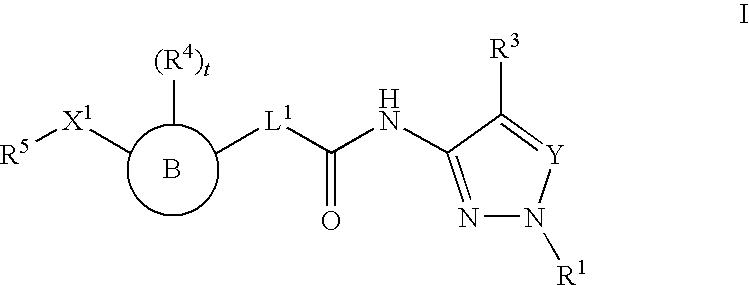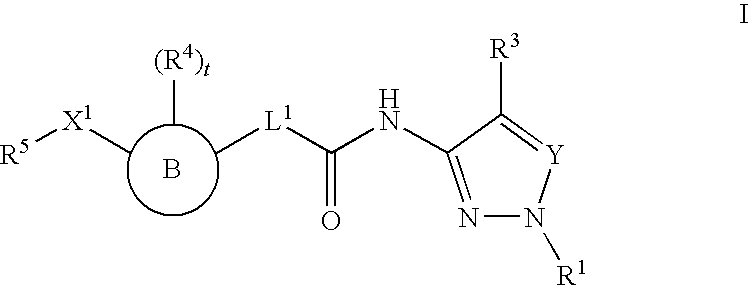Histone Deacetylase Inhibitors With Aryl-Pyrazolyl-Motifs
a technology of arylpyrazolyl and histone deacetylase, which is applied in the direction of heterocyclic compound active ingredients, biocide, drug compositions, etc., can solve the problems of excess proliferation of leukemic cell lines and inability to complete differentiation, and achieve the effect of inhibiting the proliferation of such cells
- Summary
- Abstract
- Description
- Claims
- Application Information
AI Technical Summary
Benefits of technology
Problems solved by technology
Method used
Image
Examples
example 1
[0383]
Pyridin-3-ylmethyl (4-{[(4-amino-1-phenyl-1H-pyrazol-3-yl)amino]carbonyl}benzyl)carbamate (Scheme 7)
Step A: BOP Coupling
[0384]A solution of 4-({[(pyridin-3-ylmethoxy)carbonyl]amino}methyl)benzoic acid (0.1 g, 0.35 mmol), tert-butyl (3-amino-1-phenyl-1H-pyrazol-4-yl)carbamate (0.096 g, 0.35 mmol), and N,N-diethylisopropylamine (0.049 g, 0.35 mmol) in methylene chloride (5 mL) was treated with BOP (0.23 g, 0.52 mmol) and heated to 60° C. for 1 hour. The reaction was loaded directly onto a silica column and purified by flash chromatography (0-3% methanol / methylene chloride) to give pyridin-3-ylmethyl {4-[({4-[(tert-butoxycarbonyl)amino]-1-phenyl-1H-pyrazol-3-yl}amino)carbonyl]benzyl}carbamate as a white solid. 1HNMR (CD3OD) δ 8.57 (s, 1H), 8.48 (d, J=4.99 Hz, 1H), 8.38 (s, 1H), 7.97 (d, J=7.92 Hz, 2H), 7.87 (d, J=7.92 Hz, 1H), 7.72 (d, J=7.92 Hz, 2H), 7.44 (m, 5H), 7.27 (t, J=7.33 Hz, 1H), 5.18 (s, 2H), 4.38 (s, 2H), 1.50 (s, 9H).
Step B: Deprotection
[0385]A solution of pyridin-3-...
example 36
[0387]
2-naphthyl (4-{[(4-amino-1-phenyl-1H-pyrazol-3-yl)amino]carbonyl}benzyl)carbamate (Scheme 5)
Step A: Carbamate Formation
[0388]To a solution of tert-butyl (3-{[4-(aminomethyl)benzoyl]amino}-1-phenyl-1H-pyrazol-4-yl)carbamate (15 mg, 0.04 mmol) and triethylamine (20 μL) in methylene chloride (1.5 mL) was added 2-napthylchloroformate (8 mg, 0.04 mmol). The resulting solution was stirred at ambient temperature for 16 hours. The reaction was evaporated in vacuo and purified by reverse phase LC to give the desired carbamate. ESIMS calcd 578.2 (M++H), found 578.2 (M++H).
Step B: Deprotection
[0389]To a solution of 2-naphthyl {4-[({4-[(tert-butoxycarbonyl)amino]-1-phenyl-1H-pyrazol-3-yl}amino)carbonyl]benzyl}carbamate (approximately 5 mg) in ethyl acetate (1 mL) was added 4M HCl in dioxane (1 mL). The reaction was stirred at ambient temperature for 16 hours. Evaporation in vacuo gave the title compound as a white solid. 1H NMR (600 MHz, CD3OD) δ 8.44 (s, 1H), 8.07 (d, J=8.2 Hz, 2H), 7.87...
example 44
[0391]
N-(4-amino-1-phenyl-1H-pyrazol-3-yl)-4-{[methyl(pyridin-4-yl)amino]methyl}benzamide (Scheme 6)
Step A: Reductive Amination
[0392]47 mg of FDMP stratospheres resin (loading 1.5 mmol / g) (0.07 mmol), 95.9 mg (0.35 mmol) of tert-butyl (3-amino-1-phenyl-1H-pyrazol-4-yl)carbamate, and 1 ml of 5% AcOH in DCE was added to a scintillation vial and allowed to shake overnight at room temperature. 74.2 mg (0.35 mmol) of NaBH(OAc)3 was added to the vial in 1 ml of 5% AcOH in DCE. The vial was capped and vented, and allowed to react for 3 days at room temperature. The resin was washed with each of the following solvents 3× each and dried in vacuo: DMF, MeOH, H2O, MeOH, and DCM.
Step B: Acylation
[0393]0.07 mmol of resin from the previous step was added to a scintillation vial along with 2 ml of DCM and 36 mg (0.28 mmol) of DIEA. The vial was shaken for 1 minute and 26 mg (0.14 mmol) of 4-(chloromethyl)benzoyl chloride was added. The vial was capped and vented, and allowed to react overnight at ...
PUM
 Login to View More
Login to View More Abstract
Description
Claims
Application Information
 Login to View More
Login to View More - R&D
- Intellectual Property
- Life Sciences
- Materials
- Tech Scout
- Unparalleled Data Quality
- Higher Quality Content
- 60% Fewer Hallucinations
Browse by: Latest US Patents, China's latest patents, Technical Efficacy Thesaurus, Application Domain, Technology Topic, Popular Technical Reports.
© 2025 PatSnap. All rights reserved.Legal|Privacy policy|Modern Slavery Act Transparency Statement|Sitemap|About US| Contact US: help@patsnap.com



